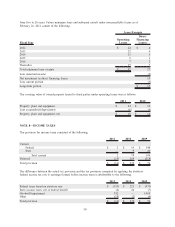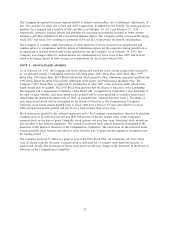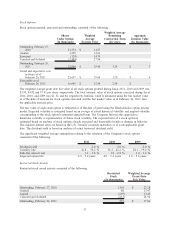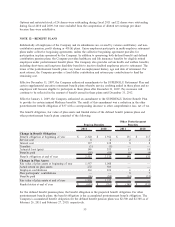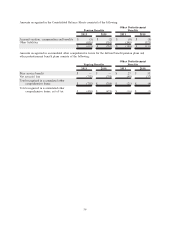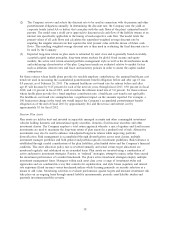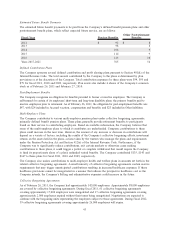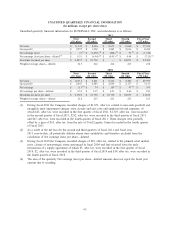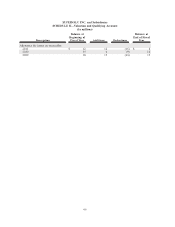Albertsons 2011 Annual Report Download - page 62
Download and view the complete annual report
Please find page 62 of the 2011 Albertsons annual report below. You can navigate through the pages in the report by either clicking on the pages listed below, or by using the keyword search tool below to find specific information within the annual report.(2) The Company reviews and selects the discount rate to be used in connection with its pension and other
postretirement obligations annually. In determining the discount rate, the Company uses the yield on
corporate bonds (rated AA or better) that coincides with the cash flows of the plans’ estimated benefit
payouts. The model uses a yield curve approach to discount each cash flow of the liability stream at an
interest rate specifically applicable to the timing of each respective cash flow. The model totals the
present values of all cash flows and calculates the equivalent weighted average discount rate by
imputing the singular interest rate that equates the total present value with the stream of future cash
flows. This resulting weighted average discount rate is then used in evaluating the final discount rate to
be used by the Company.
(3) Expected long-term return on plan assets is estimated by asset class and is generally based on widely-
accepted capital market principles, long-term return analysis for global fixed income and equity
markets, the active total return-oriented portfolio management style as well as the diversification needs
and rebalancing characteristics of the plan. Long-term trends are evaluated relative to market factors
such as inflation, interest rates and fiscal and monetary policies in order to assess the capital market
assumptions.
For those retirees whose health plans provide for variable employer contributions, the assumed healthcare cost
trend rate used in measuring the accumulated postretirement benefit obligation before and after age 65 was
8.0 percent, as of February 26, 2011. The assumed healthcare cost trend rate for retirees before and after
age 65 will decrease by 0.25 percent for each of the next six years, through fiscal 2017, 0.50 percent in fiscal
2018, and 1.0 percent in fiscal 2019, until it reaches the ultimate trend rate of 5.0 percent. For those retirees
whose health plans provide for a fixed employer contribution rate, a healthcare cost trend is not applicable.
The healthcare cost trend rate assumption has a significant impact on the amounts reported. For example, a
100 basis point change in the trend rate would impact the Company’s accumulated postretirement benefit
obligation as of the end of fiscal 2011 by approximately $12 and the service and interest cost by
approximately $1 for fiscal 2012.
Pension Plan Assets
Plan assets are held in trust and invested in separately managed accounts and other commingled investment
vehicles holding domestic and international equity securities, domestic fixed income securities and other
investment classes. The Company employs a total return approach whereby a mix of equities and fixed income
investments are used to maximize the long-term return of plan assets for a prudent level of risk. Alternative
investments may also be used to enhance risk-adjusted long-term returns while improving portfolio
diversification. Risk management is accomplished through diversification across asset classes, multiple
investment manager portfolios and both general and portfolio-specific investment guidelines. Risk tolerance is
established through careful consideration of the plan liabilities, plan funded status and the Company’s financial
condition. This asset allocation policy mix is reviewed annually and actual versus target allocations are
monitored regularly and rebalanced on an as-needed basis. Plan assets are invested using a combination of
active and passive investment strategies. Passive, or “indexed” strategies, attempt to mimic rather than exceed
the investment performance of a market benchmark. The plan’s active investment strategies employ multiple
investment management firms. Managers within each asset class cover a range of investment styles and
approaches and are combined in a way that controls for capitalization, and style biases (equities) and interest
rate exposures (fixed income) versus benchmark indices while focusing primarily on security selection as a
means to add value. Monitoring activities to evaluate performance against targets and measure investment risk
take place on an ongoing basis through annual liability measurements, periodic asset/liability studies and
quarterly investment portfolio reviews.
58




